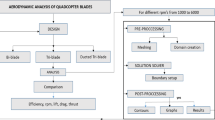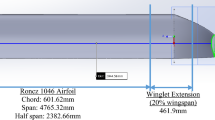Abstract
The performance of airfoil plays an important role in the performance of model aircraft. Three types of airfoils are selected in this paper: the GOE 480, MH 114, and MH 115, which are all flat-convex airfoils. Firstly, three types of airfoil were numerically analyzed by using Profili software. The results show that among the three types of flat-convex airfoils, the lift-drag ratio of MH series airfoils is higher than that of GOE 480. Then, the FEA software was used to analyze the aerodynamic performance of the wings. And the lift and drag coefficient obtained from calculation was compared with the results by Profili software. To compare the actual flight performance of the three airfoils, the control variable method and UAV self speed measurement method based on sequence images were used for the real field test. The results show that the type of MH 115 has the largest max level speed among the three types of wings.
























Similar content being viewed by others
References
Feng Y, Bo XS (2016) History of development of large transport aircraft. Polit Work Guide 9:24–25
Feng X (2014) Basic wing structure of modern aircraft. China Mach 13:177–177
Ramamoorthy P, Padmavathi K (2015) Airfoil design by optimization. J Aircr 14:219–221
Limache AC (2015) Inverse method for airfoil design. J Aircr 32:1001–1011
Song C, Qiang JB, Wei ZS et al (2014) Aerodynamic optimization design of Airfoil Based on DFFD technology. J Aeronaut 35:695–705
Xun W, Sheng JC, Kun Q et al (2015) Airfoil optimization design based on improved CST parameterization method and transition model. J Aeronaut 36:449–461
Bai P, Cui EJ, Li F (2006) Study of the nonlinear lift coefficient of the symmetrical airfoil at low Reynolds number near the 0o angle of attack. J Mech 38:1–8
Fluck M, Crawford C (2016) Fast analysis of unsteady wing aerodynamics via stochastic models. Aiaa J 55:1–10
Yu HT (2016) Low Reynolds number aerodynamics of finite wing at low reduced pitch rates. J Aeronaut Astronaut Aviat 48:83–94
Kajiwara S (2017) Passive variable rear-wing aerodynamics of an open-wheel racing car. Automot Engine Technol 2:107–117
Chin DD, Lentink D (2016) Flapping wing aerodynamics: from insects to vertebrates. J Exp Biol 219:920–932
Deng L, Qiao ZD, Yang XD (2011) Multi-point/objective optimization design of high lift-to-drag ratio for NLF airfoils. Acta Aerodyn Sin 29:330–335
Zhang J, Chu W, Zhang H (2016) Numerical and experimental investigations of the unsteady aerodynamics and aero-acoustics characteristics of a backward curved blade centrifugal fan. Appl Acoust 110:256–267
Ai Q, Azarpeyvand M, Lachenal X (2016) Aerodynamic and aeroacoustic performance of airfoils with morphing structures. Wind Energy 19:1325–1339
Wang GF, Zhang MM, Xu JZ (2013) Experimental study on bionic wavy edge aerodynamic characteristics of airfoil. J Eng Thermophys 34:1842–1846
Lian Y, Tang J, Viieru D (2008) Aerodynamics of low Reynolds number flyers. Aiaa J 47:287–287
Kim DH, Chang JW, Sohn MH (2017) Unsteady aerodynamic characteristics depending on reduced frequency for a pitching NACA0012 airfoil at Rec = 2.3 × 104. Int J Aeronaut Space Sci 18:8–16
Shubov MA (2018) Asymptotic analysis of aircraft wing model in subsonic air flow. IMA J Appl Math 66:319–356
Ding D, Che J, Qian W et al (2018) Aerodynamic parameter identification for aircraft wing icing using H∞ method. Acta Aeronaut Astronaut Sin 39:121626-1-121626–12
Prabhu L, Srinivas J (2018) Adaptive control of aircraft wing oscillations with stiffness and damping nonlinearities in pitching mode. Inf Decis Sci 701:227–235
Funding
The author(s) disclosed receipt of the following financial support for the research, authorship, and/or publication of this article: This work is supported by the National Natural Science Foundation of China (51877070, 51577048); Natural Science Foundation of Hebei Province of China (E2018208155); the Talent Engineering Training Support Project of Hebei Province, Grant no. A201905008; High-energy-saving Motor and Control Technology National and Local Joint Engineering Laboratory Open Project Funded Project (KFKT201901), Hebei Province Graduate Innovation Funding Project (CXZZSS2018085, CXZZSS2019084).
Author information
Authors and Affiliations
Corresponding author
Ethics declarations
Conflict of interest
The authors declared no potential conflicts of interest with respect to the research, authorship, and/or publication of this article.
Rights and permissions
About this article
Cite this article
Li, Z., Wang, D. Analysis and experimental study on different airfoils in heavy unmanned aerial vehicle. AS 4, 37–48 (2021). https://doi.org/10.1007/s42401-020-00072-9
Received:
Revised:
Accepted:
Published:
Issue Date:
DOI: https://doi.org/10.1007/s42401-020-00072-9




